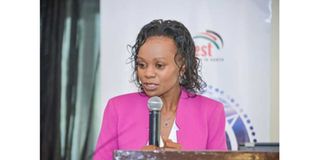The rise and rise of women to leadership roles

Kepsa CEO Carole Kariuki at Crown Plaza Hotel in Nairobi on June 29, 2017. She says diverse and inclusive boards and workplaces tend to perform better in all aspects.
What you need to know:
- Progress attributed to a favourable legal and regulatory environment, focus by organisations to prepare a pipeline of women who can be promoted to senior leadership and board positions.
- Also cited is the general awareness by key players and decision-makers as part of sustainability of every organisation to have diversity and inclusion as actors driving the change.
At the entry level, the number of women and men in employment or various offices in Kenya is more or less the same, and even favouring the former in some cases.
But along the way to the top management and boardrooms, the number of women keep decreasing, presenting a gender diversity and inclusivity conundrum.
Loosely referred to as leaky pipeline, the more equitable gender balance at the entry level soon adopts a funnel-like shape, with men dominating Kenya’s economic, political and social spheres despite women making up the majority of the population.
Glaring gender gaps still exist at the top leadership or management in Kenya more than 11 years since the promulgation of the 2010 Constitution that ushered in two-third gender rule.
It is lonely in the C-suite for women in Kenya with overall representation on boards and senior executive posts tipped in favour of men, despite past global studies showing a positive relationship between diversity in company leadership and management, and performance.
In terms of representation in Parliament, only 21.78 per cent and 30.88 per cent women sit at the National Assembly and Senate respectively, compared to Rwanda, whose female legislators account for 61.25 per cent.
In ministerial positions, the number is only marginally higher at 25 per cent, with no head of state being female as yet.
On the business front, the situation is similar. Only 13.2 per cent of firms have a majority female ownership and only 18.1 per cent of the firms in Kenya have women in top management. In media, the same situation obtains, with women forming a minority of leaders and top managers.
Giant leap
However, a report by the Kenya Institute of Management (KIM) on the state of women representation in the public and private sectors released in October this year, revealed that significant progress has been achieved in gender diversity and inclusion in the past 10 years.
The report says the overall representation of women in the top leadership currently stands at 36 per cent for women. This has been a steady gain from 12 per cent in 2012 that jumped to 18 per cent in 2015 to 21 per cent in 2017, before making the giant leap in the intervening four years to the current percentage.
In 2012, women representation in the public sector was 21 per cent, whilst in the listed companies at the Nairobi Securities Exchange (NSE), it stood at 12 per cent.
Fast forward to 2021, the representation has more than doubled at 30 per cent among the listed firms, having leaped to 23 per cent, according to an Equileap Gender Equality in Kenya report in 2019.
NSE chief executive Geoffrey Odundo says Kenya is doing much better in gender diversity in the boardroom at 36 per cent compared to the global average where women now hold 23 per cent.
Female representation in C-suite roles in Kenya currently stands at 37 per cent compared to 21 per cent globally.
He points out the journey has been slow but steady, with the numbers significantly increasing and at NSE, they have purposed to push the needle forward on women representation within boards of listed companies as they push for 50 per cent within boards and senior management.
Currently, the ratio of male to female in the listed firms is about 48 to 52 per cent, but in top management and boards, it is 70 per cent and 30 per cent, he says.
“Historically, a lot of organisations have had mainly male gender representation and it is now that we are trying to bring more women into leadership to achieve gender diversity,” says the NSE boss.
Incremental progress
Mr Odundo adds that although incremental progress is being made to achieve gender balance, organisations have to set clear internal or corporate objectives during recruitment, build database of skills to identify female leaders and work with relevant organisations to hit the coveted 50-50 gender representation.
Ms Catherine Musakali, the chairperson of the Women on Boards Network (WOBN), an initiative aimed at promoting and encouraging women into board leadership, cites concerted efforts in promoting women into top leadership.
The High Court advocate attributes the progress to a favourable legal and regulatory environment, focus by organisations to prepare a pipeline of women who can be promoted to senior leadership and board positions, and general awareness by key players and decision-makers as part of sustainability of every organisation to have diversity and inclusion as actors driving the change.
“We are doing much better, with State corporations doing better than the private sector. Currently, senior leadership is more diverse than at board positions,” avers the Institute of Certified Public Secretaries of Kenya fellow.
She is optimistic that the 50-50 representation will be achieved, though she is not sure when, as steady progress is being made, with more women also coming out for the senior roles and in some organisations, the scale is already the other way round.
Gender-sensitive policies
Ms Musakali is banking on adoption of gender diversity and inclusion policy by both private and public sectors, as well as gender budgeting, to set specific targets to be achieved in gender diversity and inclusion.
Through WoBN training, they have seen more than 60 women placed on boards and over 230 others in senior management.
“Having gender-sensitive general policies like on career progression, telecommuting, and job share geared towards having women to progress in the workplace by responding to the needs of women will ensure those leaky pipes do not exist.”
Kenya Private Sector Alliance (Kepsa), the apex body of the private sector in Kenya, Chief Executive Officer Carole Kariuki says diverse and inclusive boards and workplaces tend to perform better in all aspects.
Subsequently, in addressing some of the barriers to optimisation of board diversity and inclusion, Kepsa is finalising a policy on gender mainstreaming in the private sector to ensure inclusivity at corporate leadership and the workforce.
“We applaud the tremendous progress Kenya has made in recognising the role of women in leadership and economic development. As a result, we have seen the number of women scaling the heights in public and private sector leadership improve significantly over the last decade, compared to our peers in the region.”





